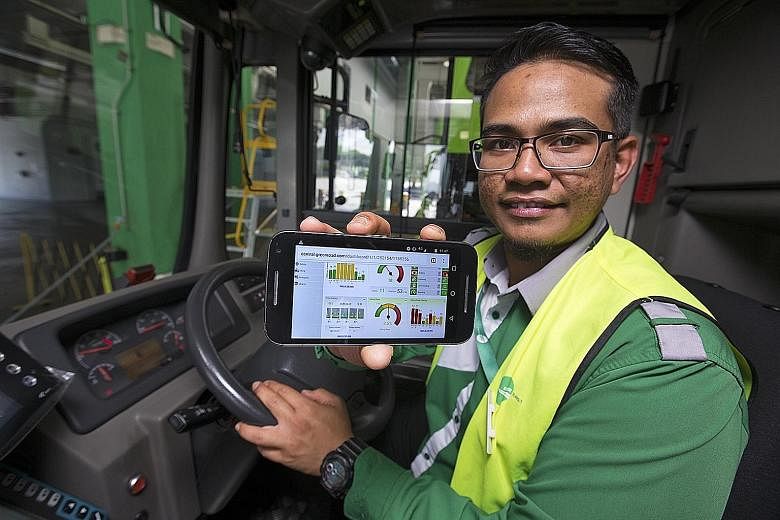Mr Amirul Hakim was once a bus driver that commuters would want to avoid if they could.
The 29-year-old with Anglo-Australian operator Tower Transit was prone to jerky stops and seat-sliding cornering. His safety demerit score on the company's Greenroad vehicle-tracking system was 165 last October - more than eight times above the recommended 20.
Thanks to the system, Tower Transit - which marks its first year in Singapore - was able to identify him for coaching.
Within a month, Mr Hakim, a driver of five years who previously worked at SBS Transit, improved his score to 72. By December, he managed to hit 20 points, qualifying him for a bonus of $130 for that month.
By April this year, he had shaved his score to 15 points, which he now maintains.
Tower Transit said the Greenroad telematics system has made its drivers smoother and safer on the road. Between last July and May this year, the system - which tracks how a vehicle is driven in real time via GPS and sensors - has significantly improved safety scores.
The percentage of drivers in the "red" zone - deemed to have consistently made unsafe moves such as hard braking and acceleration, sharp cornering and speeding - has fallen from 15 per cent to 2 per cent.
The company employs about 750 drivers. On average, their safety score has improved, from 25 points to 13 points (the lower the score, the better). Drivers who score 20 points and below a month are paid a bonus of $130, which is on top of a $100 accident-free bonus.
Over the same period, Tower Transit's accident numbers have fallen by 50 per cent, with cases where its drivers were deemed to be at fault plunging by 70 per cent. However, the company would not divulge absolute numbers.
It also refused to disclose the cost savings it had accrued from the system, or the amount it had spent on implementing it.
But for drivers such as Mr Hakim, the system has proven its worth.
Asked whether the system's colour-coded panel which flashes red, amber or green according to driving patterns was distracting, he said: "I just ignore it and focus on my driving. Once we're on the road, we have to be attentive to everything - passengers at the back, traffic in the side mirrors, and even cyclists who rest on the side of the bus at the (traffic) lights."
On top of that, drivers have to keep to a schedule. There is another device on the bus that informs drivers of the headway between buses. They may have to speed up or slow down to maintain what Mr Hakim describes as "timing".
Telematics-based systems are used widely by fleet operators elsewhere but are still relatively new in Singapore.
SMRT Buses and Go Ahead are planning to roll out a similar tracking system, while SBS Transit has been trialling a Mobileye system that helps drivers detect danger. A number of motor insurers are also using telematics-based schemes to reward safe policyholders.


